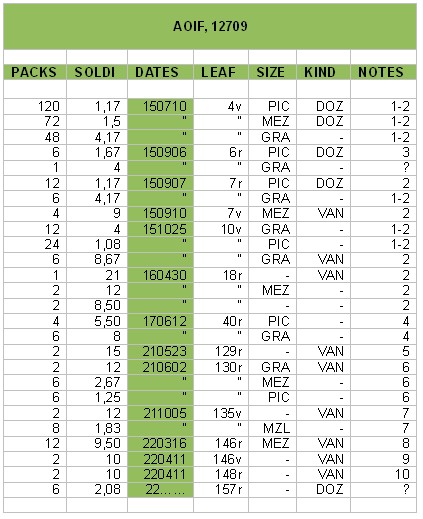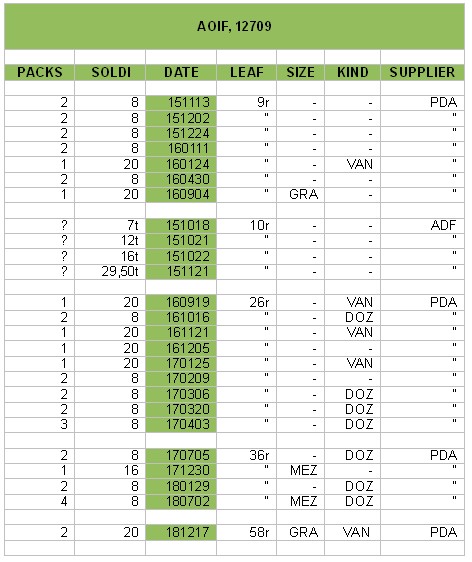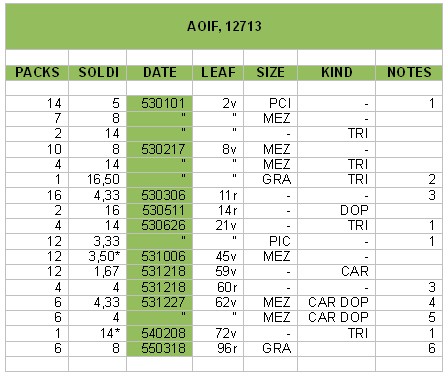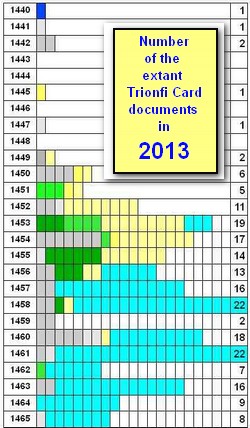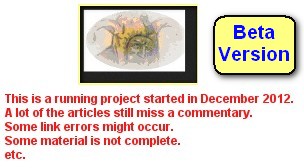Lapini family, earliest playing card trade (since 1415)
composed by Lothar Teikemeier, last update 06.12.2012
Summary of Activity: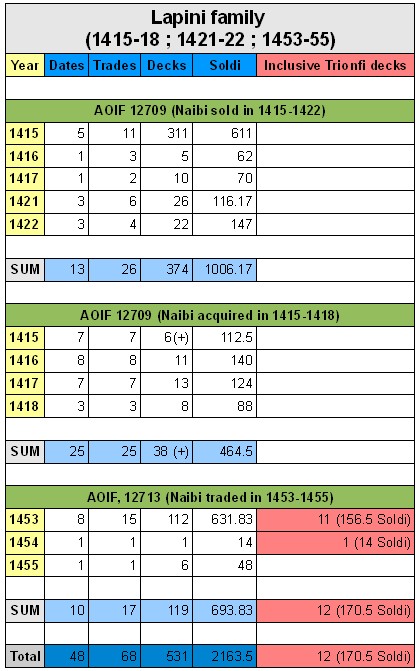
|
|
Sources
Source is taken from Franco Pratesi's new article series written from November 2011 till now, published here at Trionfi.com.| SOURCE 1: Lapini family |
|
Quote from Franco Pratesi: "NAIBI TRADED AT LAPINI STORE, FROM 1415 ON" , 10.04.2012 |
Naibi sold in 1415-1422The book in question is the first of the series, and in principle should cover the long time interval from 1415 to 1441. Unfortunately, its second part has been severely damaged and only the lower part of the pages can be read; moreover, the records themselves are there less detailed and complete. The handwriting is less fine than average, everywhere, but in the second half of the book it becomes hard to read. In conclusion, we should be satisfied, at least for the moment, with the few years for which I have been able to get the data of the following Table. As in other notes, the date is expressed as 14yymmdd and the price everywhere in soldi, with an approximation to hundredths of them, which did not correspond to any coin of the time (thus, for ex. s.8,67 should correctly be read as s.8d.8).
As mentioned before, the main reason of satisfaction is that these years are so early for playing card production that these new data become particularly interesting. This is evident just at the very beginning: thinking for July 1415 of a single purchase of no less than 240 Naibi packs, to be further sold in Lucca, is probably much more than anybody could have expected. Apparently, a local production was necessary to support a similar trade, and not of the kind of the single cardmaker who little by little produced one pack after another in the course of several months, as we were ready to expect. Naibi acquired in 1415-1418Information on cards acquired by our mercers is more difficult to detect in the book, because the corresponding trade is of a different kind. Packs are typically sold directly by cardmakers, who used them for "paying” some goods previously acquired in the store. This "payment” occurred, as usual, in successive installments, which could be recorded in the course of several months, as follows.
In the Table, a letter "t" after the soldi amount indicates that this is the total amount in soldi paid for an amount of packs that was not recorded. We are in the presence of two makers, Piero di Antonio (PDA) and Antonio di Francesco (ADF). The latter was likely the same indicated above as the maker of several packs sold in the store. We find only the record of the total price of his cards here, without any indication on unit prices. Piero di Antonio, on the other hand, appears as the supplier of the more expensive packs. Apart from one case of Naibi Mezzani recorded at 16s., all his packs were either Dozzinali, priced however as high as 8s., or Vantaggiati at 20. Apparently, he was not yet involved in any mass production, and the slow rate of his supplies may be a confirmation. Naibi traded in 1453-1455In the second book examined, we find a different and more familiar situation, corresponding to the middle of the 15th century. This is easier to compare with other account books already studied. However, there is something unusual in this book, which is thicker than similar ones, with more than three hundred leaves. It seems that the trade changed in the time of these records, with increasingly more entries concerning production rather than small trades of the shop. I have collected in the following Table all the packs that I could see in the book; namely, in its initial part.
We can observe that low-quality packs still exist, but have rather become an exception among packs recorded here; only one dozen packs priced less than 2s. are present in the entries that I have seen in this store. Also at the other extreme we find a reduction of entries: the most expensive packs are a Naibi Doppi at 16s. and a Trionfi Grandi at 16s.6d. Other Naibi packs have prices in the middle range. |
|
Repeated Note: When Ross Caldwell and me in 2003 started to collect Trionfi notes between 1442-1463, we had about 27/28 entries (which I nowadays would count as 31). The major part were the documents of Ferrara, which were collected by Gherardo Ortalli and Adriano Franceschini in the "Prince and the Playing Cards" (1996), after the base laying works of Michael Dummett and Stuart Kaplan around 1980. This collection included 2 notes about Trionfi cards in Florence, found by Franco Pratesi in his earlier work (allowances of the Trionfi game in 1450 and 1463). A graphical representation of this time (with 27 entries) shows the dominance of Ferrarese documents (in black) with a few notes only from other locations (in red; see picture to the right) In the period 2004 till October 2011 it was possible to add 4 further notes (Siena 1452, Padova 1455, Ancona c. 1460 and Valerio Marcello c. 1460), mainly thanks to information given by Thierry Depaulis. Franco Pratesi started his new article series in November 2011. Since then the list has gotten 67 new documents till September 2012 (65 of them found by Franco Pratesi, one, now the oldest of September 1440, by Thierry Depaulis, and another one by Veber Gulinelli, who controlled the earlier work of Franceschini and found an overlooked document) and nearly all are related to Florence or its surrounding. A small book (118 pages) was published around Christmas 2012, Franco Pratesi: "Playing Card Trade in 15th Century Florence" as IPCS Paper No. 7 (ISSN 0305-2133). It contains some of the articles, which before had appeared at this website, those, which treat the early time of 15th century. Thierry Depaulis commented in his foreword: "This book is a landmark in the history of early playing cards in Italy". Well, maybe not the book, but the research is clearly a landmark in various interests. For the collection of early Trionfi notes it somehow means, that we have within the year 2012 about 200 % more data for the period 1440-1462 than mankind had collected in the 200 years before. Added later: In August 2013 the new report of Arnold und Doris Esch: "Aus der Frühgeschichte der Spielkarte. Der Import von carte da giocare und trionfi nach Rom." in Gutenberg Jahrbuch 2013, 88. Jahrgang, p. 41-53, arrived in our redaction. It contains 106 new references to Trionfi decks, which all were found in the customs registers of the city Rome for the period 1453-1465. With this the number of all earlier Trionfi cards records has been doubled and should have reached then c. 210 (from which a few are only considered to be "Trionfi card notes" and don't contain the word "Trionfi" or something similar). *********** I'd started to sort the new Trionfi card documents overview in October 2012. Articles will be possibly changed according improvements in research. |
|
